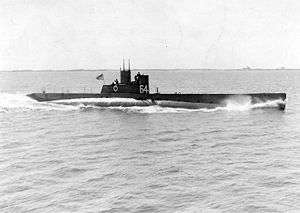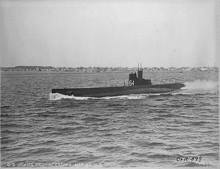USS O-3 (SS-64)
 | |
| History | |
|---|---|
| Name: | USS O-3 |
| Ordered: | 3 March 1916 |
| Builder: |
Fore River Shipbuilding Company, Quincy, Massachusetts Puget Sound Navy Yard, Bremerton, Washington |
| Laid down: | 2 December 1916 |
| Launched: | 27 September 1917 |
| Commissioned: | 13 June 1918 |
| Decommissioned: | 6 June 1931 |
| Recommissioned: | 3 February 1941 |
| Decommissioned: | 11 September 1945 |
| Struck: | 11 October 1945 |
| Fate: | Sold for scrap, 4 September 1946 |
| General characteristics | |
| Type: | O-class submarine |
| Displacement: |
|
| Length: | 172 ft 3 in (52.5 m) |
| Beam: | 18 ft 1 in (5.5 m) |
| Draft: | 14 ft 5 in (4.4 m) |
| Installed power: |
|
| Propulsion: |
|
| Speed: |
|
| Range: | 5,500 nmi (10,200 km; 6,300 mi) at 11.5 knots (21.3 km/h; 13.2 mph) on the surface |
| Test depth: | 200 feet (61.0 m) |
| Complement: | 2 officers, 27 men |
| Armament: |
|
USS O-3 (SS-64) was one of 16 O-class submarines built for the United States Navy during World War I.
Description
The O-class submarines were designed to meet a Navy requirement for coastal defense boats.[1] The submarines had a length of 172 feet 3 inches (52.5 m) overall, a beam of 18 feet 1 inch (5.5 m) and a mean draft of 14 feet 5 inches (4.4 m). They displaced 521 long tons (529 t) on the surface and 629 long tons (639 t) submerged. The O-class submarines had a crew of 29 officers and enlisted men. They had a diving depth of 200 feet (61.0 m).[2]
For surface running, the boats were powered by two 440-brake-horsepower (328 kW) diesel engines, each driving one propeller shaft. When submerged each propeller was driven by a 370-horsepower (276 kW) electric motor. They could reach 14 knots (26 km/h; 16 mph) on the surface and 10.5 knots (19.4 km/h; 12.1 mph) underwater. On the surface, the O class had a range of 5,500 nautical miles (10,200 km; 6,300 mi) at 11.5 knots (21.3 km/h; 13.2 mph).[2]
The boats were armed with four 18-inch (45 cm) torpedo tubes in the bow. They carried four reloads, for a total of eight torpedoes. The O-class submarines were also armed with a single 3"/50 caliber deck gun.[2]
Construction and career
O-3 was laid down on 2 December 1916 by Fore River Shipbuilding Company in Quincy, Massachusetts. She was launched on 27 September 1917, and commissioned on 13 June 1918 with Lieutenant G. L. Dickson in command.

The new submarine joined the Atlantic coastal patrol and kept watch for U-boats from Cape Cod to Key West, Florida. In November, she joined a 20-submarine contingent that departed Newport, Rhode Island, on 3 November for service in European waters. However, before the ships had reached the Azores, the Armistice with Germany ended the fighting.
After the war that had proved the worth of subs, O-3 sailed to New London, Connecticut, to train Submarine School students. Reclassified as a second line submarine on 25 July 1924 while at Coco Solo, Panama Canal Zone, and reverting to a first liner on 6 June 1928, the vessel remained at New London until she moved to Philadelphia, Pennsylvania, to decommission on 6 June 1931.
As American involvement in World War II became imminent, O-3 recommissioned at Philadelphia on 3 February 1941 and sailed to New London in June to train submarine personnel at the submarine school there until war's end. She then steamed to Portsmouth, New Hampshire, to decommission on 11 September 1945. She was struck from the Naval Vessel Register on 11 October 1945 and sold to John J. Duane Company, for scrapping on 4 September 1946.
Awards
- World War I Victory Medal
- American Defense Service Medal
- American Campaign Medal
- World War II Victory Medal
Notes
References
- Friedman, Norman (1995). U.S. Submarines Through 1945: An Illustrated Design History. Annapolis, Maryland: Naval Institute Press. ISBN 1-55750-263-3.
- Gardiner, Robert & Gray, Randal, eds. (1984). Conway's All the World's Fighting Ships: 1906–1921. Annapolis, Maryland: Naval Institute Press. ISBN 0-85177-245-5.
- This article incorporates text from the public domain Dictionary of American Naval Fighting Ships. The entry can be found here.
External links
- Photo gallery of USS O-3 at NavSource Naval History